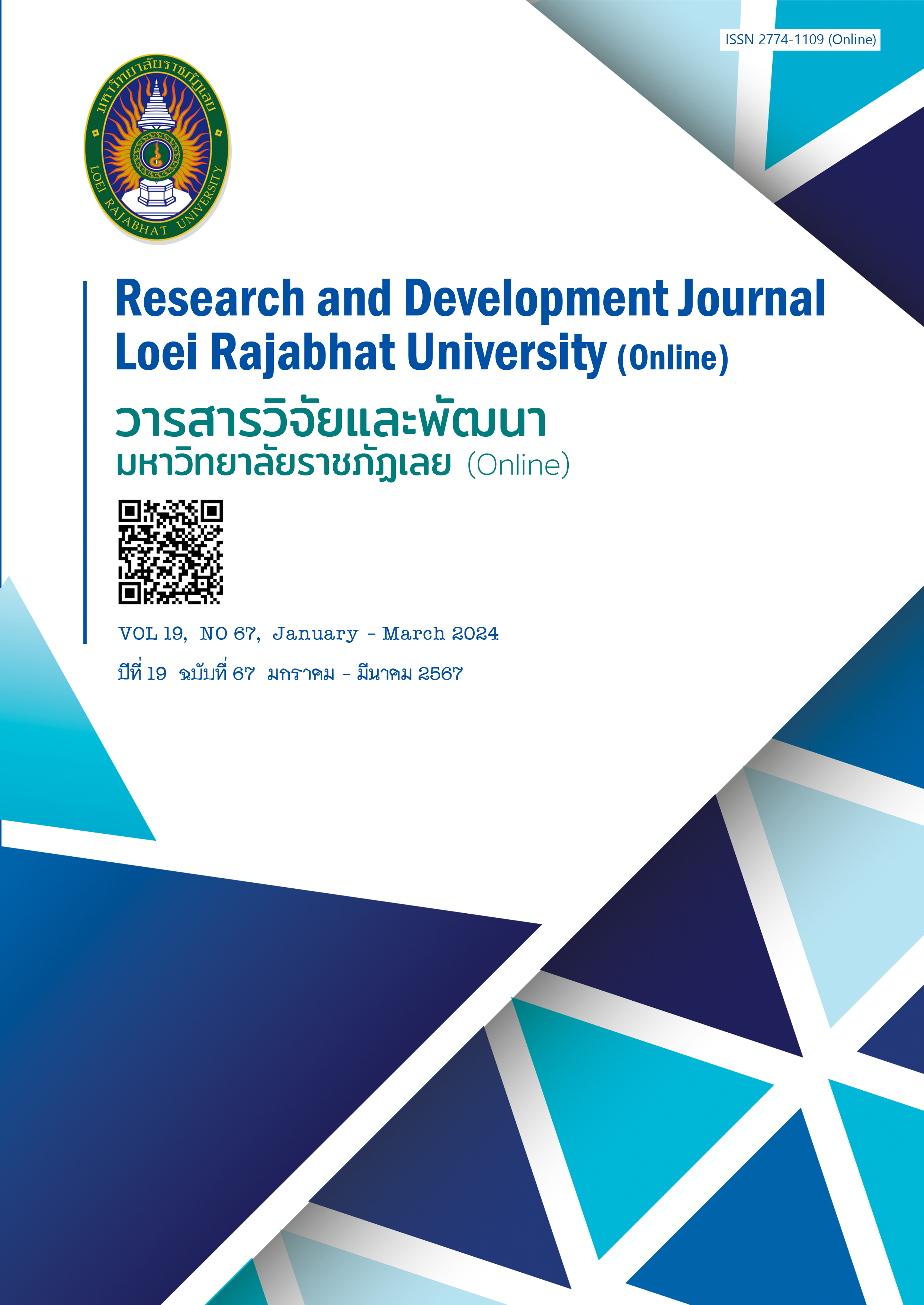An Analysis of the Potential of Entrepreneur Institutions and Rubber Collectors and Processors in Loei Province
Keywords:
potential analysis, entrepreneur institutions, rubber collectors and processorsAbstract
This research aimed to: 1) study the potential levels of entrepreneur institutions and rubber collectors and processors in Loei province.; and 2) analyze the potential of the entrepreneur institutions and rubber collectors and processors in order to create the strategy for trading development in Loei province. This research is a mixed method research. The samples, selected by using purposive sampling technique, were 10 entrepreneur institutions and processors in agricultural industry in Loei province to participate in the project and 6 officers working for rubber development who had experience, were expert, and were responsible for this. The research tools comprised an interview and a structural questionnaire. The data was analyzed with descriptive statistics namely percentage, mean, and standard deviation, and the strategy was evaluated from SWOT Analysis.
The study showed that the potential of internal factors of entrepreneur institutions and rubber collectors and processors in Loei Province had the strength that there was a certain market for selling rubber products. The potential was at a high level. The weakness was bargaining power with the market for rubber products to resell, and insufficient financial loans to create liquidity. The potential was at a low level. There was a chance that the government offered funding support. The government had policies and measures to help continuously, rubber product buyers made sufficient income to support their family wealthily, and farmers used technologies that promote the production of a variety of rubber resulting in buying rubber products with a high potential. For obstacle, the current economic situation affected the income from the sale of rubber products with a low level of potential. There were 4 strategies obtained: 1) Market development strategy for buying rubber products; 2) Local marketing strategy; 3) Capital support strategy; and 4) Network building strategy. Loei Provincial Finance Executive Board as well as agencies involving in rubber promotion can apply these strategies to develop trade development projects in the area.
References
จักรี สุจริตธรรม, เชิดเกียรติ กุลบุตร และ สุวารีย์ ศรีปูณะ. (2561). การสร้างความมั่นคงทางสังคมด้วยกระบวนการกลุ่มในการพัฒนาเกษตรกรชาวสวนยางพาราแบบครบวงจรในจังหวัดเลย. วารสารวิชาการธรรมทรรศน์, 18(3), 14.
ชิราภรณ์ วงศ์แสน. (2559). การวิเคราะห์ศักยภาพของประเทศสมาชิก ประชาคมเศรษฐกิจอาเซียนเพื่อกำหนดยุทธศาสตร์การรองรับเงินทุนไหลเข้าจากต่างประเทศ. วารสารเศรษฐศาสตร์และกลยุทธ์ การจัดการ, 3(2), 70 - 82.
โซเฟีย แวหะมะ. (2561). การวิเคราะห์ศักยภาพของผู้ประกอบการรับซื้อผลผลิตยางพารารายย่อยเพื่อกำหนดกลยุทธ์ในการพัฒนาการค้าในพื้นที่สามจังหวัดชายแดนใต้. วารสารวิทยบริการ มหาวิทยาลัยสงขลานครินทร์ (2561), 29(3), 102 -116.
บัญชา สมบูรณ์สุข, ประวัติ เวทย์ประสิทธิ์, ปุรวิชญ์ พิทยาภินันท์, และ วิโชติ จงรุ่งโรจน์. (2558). ศึกษาศักยภาพและการจัดการ ของแรงงานครัวเรือนในระบบการผลิตยางพาราขนาดเล็ก: กรณีศึกษาพื้นที่ปลูกยางพาราดั้งเดิมในภาคใต้ของประเทศไทย. วารสารเกษตรศาสตร์ (สังคม), 36(2), 258 - 270.
บุญชม ศรีสะอาด. (2545). การวิจัยเบื้องต้น (พิมพ์ครั้งที่ 7). กรุงเทพฯ: สุวีริยาสาส์น.
ปัชฌา ตรีมงคล. (2559). การพัฒนากลยุทธ์การจัดการความรู้เชิงรุก สำหรับชุมชนผู้ผลิตวัตถุดิบในห่วงโซ่อุปทานกิจการเพื่อสังคม (วิทยานิพนธ์ปริญญาดุษฎีบัณฑิต). มหาวิทยาลัยศิลปากร, กรุงเทพฯ.
พัชรี หล้าแหล่ง. (2555). แนวทางการพัฒนาเศรษฐกิจชุมชนตาม ปรัชญาเศรษฐกิจพอเพียงของกลุ่มสหกรณ์ผู้ปลูกกาแฟ จังหวัดชุมพร จำกัด. วารสาร Veridian E-Journal, SU, 5(1), 586 - 601.
พุฒิสรรค์ เครือคำ, และ พนิตพิมพ์ สิทธิศักดิ์. (2560). การวิเคราะห์ระบบตลาดและส่วนเหลื่อมการตลาดยางพาราของเกษตรกรรายย่อยในจังหวัดเชียงรายและพะเยา. วารสารการพัฒนาชุมชนและคุณภาพชีวิต, 5(2), 330-339.
มณิสร อนันต๊ะ, สุกัลยา ศิริฟองนุกูล, และ สมจิตต์ ศิขรินมาศ. (2553). รูปแบบการซื้อขายยางก้อนถ้วยในภาคตะวันออกเฉียงเหนือ. กรุงเทพฯ: คลังผลงานวิจัย กรมวิชาการเกษตร.
มหาวิทยาลัยสุโขทัยธรรมาธิราช. (ม.ป.ป.). เรื่องที่ 5.1.3 ปัจจัยในการกำหนดราคา. สืบค้นจาก https://www.stou.ac.th/stouonline/lom/data/sms/market/unit5/Subm1/U513-1.htm
ศิริชัย กาญจนวาสี. (2544). ทฤษฎีการทดสอบแบบดั้งเดิม (พิมพ์ครั้งที่ 4). กรุงเทพฯ: โรงพิมพ์แห่งจุฬาลงกรณ์มหาวิทยาลัย.
สำนักงานเกษตรและสหกรณ์จังหวัดเลย. (2563, 1 กรกฏาคม). ข้อมูลทั่วไปและข้อมูลด้านการเกษตร จังหวัดเลย ประจำปี 2562. สืบค้นจาก https://www.opsmoac.go.th/loei-performance-files-431991791857.
สำนักงานคลังจังหวัดเลย. (2564, 30 กันยายน). รายงานผลการประเมินโครงการนำร่องยกระดับรายได้เกษตรกรจังหวัดเลยด้วยการปรับเปลี่ยนวิถีการผลิตและการขายยางพาราสู่การพัฒนาที่ยั่งยืน. สืบค้นจาก https://www.cgd.go.th/cs/lei/lei/5.2ผลงาน/บทความวิชาการ.html
สุภาภรณ์ พวงชมพู และ เพียรศักดิ์ ภักดี. (2554). รูปแบบการค้า น้ำยางสดของเกษตรกรในภาคตะวันออกเฉียงเหนือตอนบน. วารสารแก่นเกษตร, 39(ฉบับพิเศษ), 236 - 240.
สุรพงษ์ คงสัตย์ และ ธีรชาติ ธรรมวงค์. (2558, 25 พฤศจิกายน). การหาค่าความเที่ยงตรงของแบบสอบถาม (IOC). สืบจาก https://www.mcu.ac.th/article/detail/14329
โสมรัตมิ์ จันทรัตน์, อัจจนา ล่ำซำ, ณรงค์ฤทธิ์ อดุลย์ฐานานุศักดิ์, ลัทธพร รัตนวรารักษ์, ชนกานต์ ฤทธินนท์ และ บุญธิดา เสงี่ยมเนตร. (2563, 15 พฤษภาคม). ครัวเรือนเกษตรไทยในวิกฤติโควิด-19. สืบค้นจาก https://www.pier.or.th/abridged/2020/11/
Downloads
Published
How to Cite
Issue
Section
License
Copyright (c) 2024 Research and Development Journal, Loei Rajabhat University

This work is licensed under a Creative Commons Attribution-NonCommercial-NoDerivatives 4.0 International License.
ข้อความที่ปรากฎในวารสารฉบับนี้เป็นความคิดเห็นของผู้เขียนแต่ละท่าน สถาบันวิจัยและพัฒนา มหาวิทยาลัยราชภัฏเลย และกองบรรณาธิการ ไม่จำเป็นต้องเห็นด้วยและไม่มีส่วนรับผิดชอบใดๆ
สถาบันวิจัยและพัฒนา มหาวิทยาลัยราชภัฏเลย ขอให้ผู้อ่านอ้างอิงในกรณีที่ท่านคัดลอกเนื้อหาบทความในวารสารฉบับนี้






